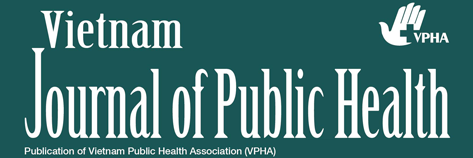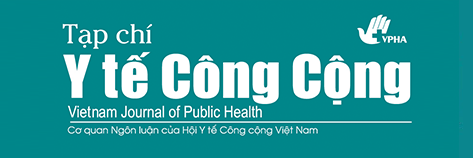Assessment of Health Status across Different Types of Migrant Populations in Hanoi -Vietnam:A Cross-Sectional Study Using SF 36 Version 2
Abstract
Objective: The study aimed to use the Vietnamese SF-36v2 to compare health status across four groups: non-migrants, migrants working in industrial zones (IZ), migrants working in private small enterprises (PSE), and seasonal migrants. Method: This cross- sectional study included 1800 non-migrants and migrants aged 18-55 in Long Bien and Ba Dinh districts, Ha Noi. The original Vietnamese SF-36v2 under a license of Qualitative Metric Incorporated was used to measure health status of participants. Results: Regarding physical health seasonal migrants are weaker than non-migrants and other migrant populations (OR=1.54, p=0.042). Migrants working in IZ are the most likely to have mental ill-health than others (OR=1.92, p<0.001). For physical health, age, gender, and monthly income are important correlates; meanwhile, gender, income, and working time are correlates of mental health. These special migrant sub-groups need to be more targeted in future health interventions, health care and access to health service programs.
Keywords
Full Text:
Download PDFReferences
UNDP. Internal Migration: Opportunities and challenges for social-economic development in Viet Nam. Ha Noi, Viet Nam: 2010.
Phan D, Coxhead I. Inter-provincial migration and inequality during Vietnam’s transition. Journal of Development Economics. 2010;91(1):100-12.
Viet Nam National Assembly. Resident Law No. 81/2006/QH11 dated 29 November 2006. Ha Noi, Viet Nam2006.
GSO. The 2009 Viet Nam Population and Housing Census of 00.00 hours 1st April 2009: Expanded sample results: Khoa hoc Cong nghe Moi Printing Joint – Stock Company; 2009.
Liem NT. Youth internal migration and development in contemporary Vietnam. Workshop on Migration, Development and Poverty Reduction; 5-6/10/2009; Ha Noi, Viet Nam2009.
GSO. Viet Nam Population and Housing Census 2009, Migration and Urbanization in Viet Nam: Patterns, Trends, and Differentials. General Statistics Office, Ministry of Planning and Investment, 2011.
Resurreccion B, Ha T. Able to come and go: reproducing gender in female rural-urban migration in the Red River Delta. Population, Space and Place. 2007;13:211-24.
Asian Development Bank. Implementation of the Environmental Management Plan for the Son La Hydropower Project. Ha Noi, Viet Nam: Asian Development Bank (ADB), 2005.
Guest P. Bridging the Gap: Internal Migration in Asia. In: Tienda M., Findley E.S., Tollman S., E P-W, editors. Africa on the move: African migration and urbanisation in comparative respective. Conference on African Migration in Comparative Perspective
Johannesburg, South Africa: Wits University Press; 2006. p. 180-93.
Deshingkar P. Internal migration, poverty and development in Asia. Promoting growth, ending poverty Asia 2015; Session 3: Realizing the potential for poverty reduction, parallel group 3A: topic paper 2: Institute of Development Studies and Overseas Development Institute; 2006.
UNDP. Overcoming barriers: human mobility and development. New York: 2009.
Skeldon R. Rural-to-urban migration and its implications for poverty alleviation. Asia-Pacific Population Journal. 1997;12(1):3-16.
VanLandingham M. Impacts of Rural to Urban Migrant on the Health of Young Adult Migrants in Ho Chi Minh City, Vietnam. Johannesburg, South Africa, 4 - 7June, 2003: 2003.
GSO. The 2004 Migration Survey: Migration and Health. Ha Noi, Viet Nam: SAVINA Printing Company; 2006.
WHO. Preamble to the Constitution of the World Health Organization as adopted by the International Health Conference, New York, 19-22 June, 1946; signed on 22 July 1946 by the representatives of 61 States (Official Records of the World Health Organization, no. 2, p. 100) and entered into force on 7 April 1948.
CDC. Measuring Healthy Days. Atlanta, Georgia: CDC, November 2000.
McHorney CA. Health status assessment methods for adults: past accomplishments and future challenges. Annual Review of Public Health. 1999;20:309-35.
Maruish M. E., editor. User’s manual for the SF-36v2 Health Survey (3rd ed.). Lincoln, RI: QualityMetric Incorporated2011.
Brazier JE, Harper R, Jones NMB, O'Cathain A, Thomas KJ, Usherwood T, et al. Validating the SF-36 health survey questionnaire: new outcome measure for primary care. BMJ. 1992;305:160-4.
Crispin Jenkinson, Angela Coulter, Lucie Wright. Short form 36 (SF 36) health survey questionnaire: normative data for adults of working age. BMJ. 1993;306:1437-40.
L Li, H M Wang, Y Shen. Chinese SF-36 Health Survey: translation, cultural adaptation, validation, and normalisation. Journal of Epidemiology Community Health. 2003;57:259-63.
Ware JE Jr, Kosinski M, Gandek B, Aaronson NK, Apolone G, Bech P, et al. The factor structure of the SF-36 Health Survey in 10 countries: results from the IQOLA Project. International Quality of Life Assessment. Journal of Clinical Epidemiology. 1998;51(11):1159-65.
Crispin Jenkinson, Sarah Stewart-Brown, Sophie Petersen, Colin Paice. Assessment of the SF-36 version 2 in the United Kingdom. Journal of Epidemiology Community Health. 1999;53:46-50.
Fukuhara S, Bito S, Green J, Hsiao A, Kurokawa K. Translation, adaptation, and validation of the SF-36 Health Survey for use in Japan. Journal of Clinical Epidemiology. 1998;51(11):1037-44.
Lynette L-Y Lim, Sam-ang Seubsman, Adrian Sleigh. Thai SF-36 health survey: tests of data quality, scaling assumptions, reliability and validity in healthy men and women. Health and Quality of Life Outcomes. 2008;6(52).
Ngo-Metzger Q, Sorkin DH, Mangione CM, Gandek B, RD. H. Evaluating the SF-36 Health Survey (Version 2) in Older Vietnamese Americans. Journal of Aging and Health. 2008;20(4):420-36.
Viet Nam Goverment. Decree on assistance to development of small business Ha Noi, Viet Nam2009.
GSO. The 2004 VietNam Migration Survey: The quality of life of migrants in VietNam. General Statistics Office and United Nations Population Fund, 2004.
GSO. VietNam Population and Housing Census 2009: Migration and Urbanization in VietNam: patterns, trends and differentials. Ha Noi, VietNam: Khoa hoc Cong nghe Moi Printing Joint – Stock Company; 2011.
Le DB, Nguyen LT. From countryside to cities: socioeconomic impacts of migration in VietNam. Workers' Publishing House: Institute for Social Development Studies, 2011.
Nghi NQ. Labours in industrial zones in Tien Giang. Journal of Events and Numbers. 2010;August:30-1.
Vic Velanovich. Behavior and Analysis of 36-Item Short-Form Health Survey Data for Surgical Quality-of-Life Research. Arch Surg. 2007;142:473-8.
Hull D. Migration, adaptation, and illness: a review. Social Science and Medicine. 1979;13(A):25-36.
Kristiansen M, Mygind A, Krasnik A. Health effects of migration. Dan Med Bull. 2007;54:46-7.
World Health Organisation. Health of Migrants - The way forward. Madrid, Spain: WHO press, World Health Organisation, Geneva, Switzerland, 2010 3-5 March 2010. Report No.
Yingchun Peng, Wenhu Chang, Haiqing Zhou, Hongpu Hu, Wannian Liang. Factors associated with health-seeking behavior among migrant workers in Beijing, China. BMC Health Services Research. 2010;10(69).
Evi Nurvidya Arifin, Aris Ananta, Sureeporn Punpuing. Impact of Migration on Health in Kanchanaburi, Thailand. The XXVth IUSSP International Population Conference; 18-23 July; Tours, France18-23 July 2005.
Du T, Nghia N, Ha N, Nhan N, Loughry M. Femal rural migrant workers in the informal sector in HoChiMinh City, Viet Nam. Women's Studies Department, Open University of HoChiMinh City, 2006.
Chinh ND, editor Migrant workers in Viet Nam: Patterns and Related Issues. In "Internal Migration and Social Issues in international economic integration". National Science Conference; 2007; Ha Noi, Viet Nam: Culture Publisher.



